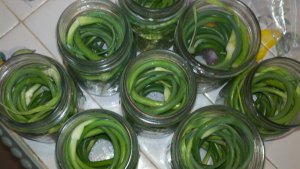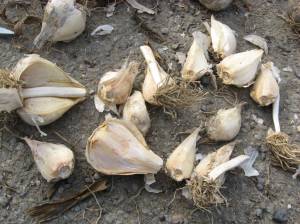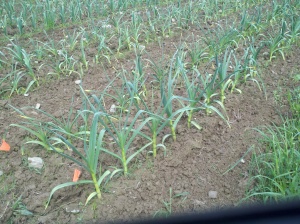One of the last few tasks in the garden each year is that of planting garlic. You can buy garlic heads to plant at a farmstand or farmers market. The grocery store is not the best place, as what they have is likely to come from elsewhere, and you want something grown close to your location, so you know it will grow well. Take your heard and break it apart to reveal several individual cloves. These are what you will plant. Look at them closely, the end with the tiny point is the top, the bottom being the roots. Plant them root down. They will grow if planted upside-down, but they will not get as big. (They are interesting to look at, though!) Plant the largest of your cloves, eat the smaller ones: The larger the love, the larger the finished head of garlic next year.
Garlic grows best when planted in the fall, anytime after October 1st until the ground is frozen. Technically, the earlier it is planted, the better as it has more time to root in a little before winter sets in. But really it will usually do well no matter when you get around to planting it. Just remember, the later one waits, the colder, wetter and heavier the soil, and generally the less pleasant the task.
Since garlic cloves will be sleeping in the ground all winter, remember they will be subjected to the heaving up of the soil that naturally occurs when the ground it freezing and thawing with the changing weather. Garlic cloves that are not planted deep enough can actually heave right up out of the soil, and left sitting on top of the ground, they will most likely rot. There are a few ways of dealing with this, depending on you situation. When planting garlic, try to get the cloves at least 3 if not 4 inches into the ground. A handy way to measure is to use a trowel with measurements on it, or get an old stick and mark in at 4″.
If your soil is less than desirable and you can not get it in that deep, cover your planting when you are finished with some sort of mulch or covering, such as straw, grass clippings, compost, or even newspaper. The garlic will send out green shoots in the spring. It will grow right up through hay, compost or clippings; newspaper will have to be lifted off with a rake as soon as the first shoots appear.
Plant the garlic 4-6 inches apart, in rows about 12″ apart for row culture. Garlic is from the genus Allium, in the same family as onions, chives, shallots and leeks. All Alliums also respond well to growing in”clumps”, and many growers plant their garlic in this way, close together yet spaced enough so each plant has room to grow, but touching each other when full sized. Alliums also tolerate cold weather well, and are often the first green shoots to come up each spring.
Garlic usually pokes through as early as late March. It’s always nice to see the first shoots, an affirmation both of Spring being not far off, and of your success in planting the garlic! If you have heavily mulched them, gently pull the covering aside and let Nature take its course.
The only other thing you need to do with the growing garlic is remove the Scapes. Scapes are the term for the garlic’s flower stem which usually appears in June. When let to grow, these stems will curve beautifully into a corkscrew pattern a short time before they ultimately straighten up and produce a number of little bulbits. These bulbits can be planted and will produce garlic heads, but it takes 4 years for them to reach full-size. (These garlic bulbits are terrific to save a few however, for they make great garlic pills, being live and active, and are far better product than can be bought in the store.) To remove the scapes, let them grow and curve at least one full circle: If cut too soon, they will simply regrow, and you also will be missing the chance to do some really great cooking! Cut the scapes with a knife or scissors. You can either compost them, or cook with them!
The scapes have a wonderful garlic flavor, slightly milder but not unsatisfying to the garlic-lover’s palate. They can be used like a scallion, chopped or minced and tossed into cold and hot dishes. My favorite way to prepare (and preserve) them is to throw them in the food processor with some olive oil, and chop them into a nice paste that look much like a Pesto. This can be used as is, tossed on pasta or to make garlic bread, salad dressings, etc. Or if you have a good quantity, you can put this green paste into ice cube trays and freeze. Once frozen, pop them back out of the trays and into freezer bags to use all winter, or the rest of summer while you wait for the garlic heads to finish. Another wonderful thing to do with scapes is to pickle them.

Pickled Scapes Contributed by (Allen’s Old Barn Hollow Farm)
1 lb scapes 1/4 c. canning salt 2 tsp. mustard seed 1 tsp. dill seeds 2 3/4 c. white vinegar 2 3/4 c water Pack scapes in hot jars. Boil the rest of the ingredients for 1 minute. Pour into jars leaving 1 inch head space. Put on lids and WB for 10 min. makes 3-4 pints
Garlic is finished and ready to harvest any time between late -July and mid-August, depending on the variety you’ve panted. Garlic should not sit in the ground until the tops die back, though this is a popular myth. By then the garlic underground has split its paper, and is less desirable for cooking and storage. Burst bulbs are fine for planting, however. the garlic should be pulled when only the bottom two leaves are obviously dead. Digging one to check is fine. Properly planted garlic will need to dug to loosen the roots when harvesting, otherwise pulling alone may lead to broken stems and lost garlic. Just use caution, do not jab the shovel in too close or the head may be severed. If you do cut up some bulbs during harvest, these will not keep, and thus should be eaten up first.
Once pulled, the garlic can sit on the ground in the garden for a day or two to cure and dry the papers if the weather will be sunny. Then the garlic should be bunched (or braided) and hung in a dark, airy place to finish curing for a couple weeks. Garlic is perfectly edible before the curing, but you will notice the papers are not fully developed and it’s a bit more effort to peel it. For fresh garlic, you are not likely to mind.
Once cured, the stems can be cut and the garlic stored in onion bags or baskets in a cool dry place, such as a pantry. (Don’t forget to select you planting stock for the next year! Pull out the biggest heads and/or cloves to plant; this will increase the size of your heads every year.) They need dry conditions to store, the fridge is not the best place. Garlic will normally store until about New Years, some varieties longer. To keep your garlic supply going longer, there’s a couple things to try. One is to peel the individual cloves and store them in a jar in the refrigerator. These should stay crisp for fresh mincing. You can also put the cloves in the freezer, but when they thaw they will not be crisp. They are still great for sauces, etc, though. Garlic can also be minced and mixed with oil to refrigerate or freeze. Garlic is excellent to pickle, as well. A great way to store it for years is to peel and slice the cloves, then dehydrate. The dehydrated garlic can be thrown whole into sauces or stews, or blended/mortared into garlic powder and used as is. This works really well, definitely worth the investment in the dehydartor!
Share your garlic stories, recipes, your favorite way to store it, and your favorite varieties! Mine currently are German White, Spanish Roja, and Carpathian. What are you planting?












Dec 09, 2011 @ 19:57:34
Thank you for hat fantastic post. I have been toying with planting some of the purple garlic we bought in France earlier in the year. It is just beginning to go green in the centre. I have to give it a go.
Conor
Dec 09, 2011 @ 21:18:12
Hi, Honey. I love garlic and think I will try to plant some next fall. I will have to try to find some local to plant. I have a friend from church that is a market gardener so he may have some. I will try.
Oct 15, 2013 @ 11:37:00
Reblogged this on Sunny Hill Farm Blog and commented:
Now’s the time to prepare to plant your own garlic.